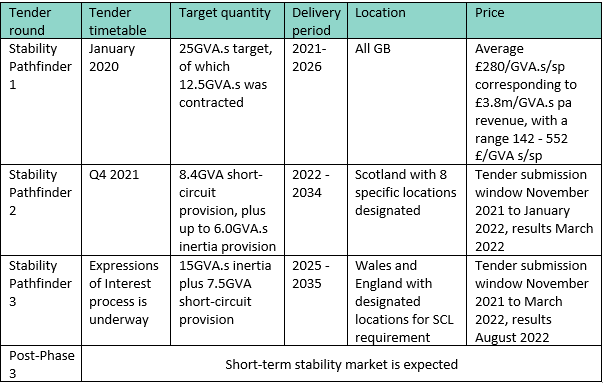Background
National Grid’s new Stability Pathfinder services offer potential revenue for participants which can provide extra inertia and short-circuit support. The Pathfinders are needed for National Grid’s aim of a zero-carbon system, where possible, by 2025, meaning no fossil fuels run for stability only. EnAppSys have the market knowledge and data to support parties interested in Pathfinder activity.
Our Consultancy Team has carried out studies for a number of clients to support their development of bidding strategies guided by our forecasts of expected system requirement in the long-term and the corresponding value of service provision under alternative market scenarios. Our experience of the market coupled with our data services have enabled us to develop our competitor analysis and bidding strategies products, plus forecasts of inertia requirements post-Pathfinder, based on Future Energy Scenario fuel mixes.
The Service
As the country moves towards greater levels of renewable generation, there will be less and less traditional synchronous generation on the system. This means less system stability in the form of inertia, voltage support and short circuit ride-through capability is available from these traditional sources. To counteract this, and find new providers of these stability services, National Grid has set up its Stability Pathfinder service tenders. These Pathfinders are designed to secure stability provision for multiple years and so can provide a revenue stream for assets able to provide the needed stability as summarised in the table below:

By investing in these stability services from non-fossil fuel-fired generation, National Grid is working towards its target of running a zero-carbon grid by 2025, on occasions where sufficient renewable and nuclear generation is available to meet demand. Stability from other technologies through the Pathfinders should mean that, in future, no fossil fuel-fired generation would have to be run purely for stability.
The Phase 1 Stability Pathfinder ran in January 2020. It was based across Scotland, England and Wales and was focussed on inertia provision. It aimed to secure 25.0GVA.s of inertia, from 2020 to 2026, of which 12.5GVA.s was procured, at an average price of ~£250/GVA.s/sp, with the highest prices seen by a synchronous condensor in Rassau, Wales (£552/GVA.s/sp) and the Cruachan pumped storage site in Scotland (£486/GVA.s/sp). Whilst inertia is non-locational, these two units are in areas of particular stability need, which appears to have given them the ability to achieve a premium price in that tender over sites in England.
Phase 2 is focussed on Short Circuit Level (SCL) in 8 specific locations in Scotland and the tender process is due to start this November. As SCL is the main service to procured, location of provision is more important than for inertia, so this is another factor to be considered in addition to unit capabilities and financials.
Phase 3 has recently been announced and the Expressions of Interest process is underway, with the service due to start in April 2025. The process has been streamlined with tendering for Phase 3 starting this November and so partly overlapping with that for Phase 2. Post Phase 3, there is currently expectation of a short-term stability market, the design of which began this September, with participation from units with grid-forming capabilities.
EnAppSys Platform Product
Additionally, the EnAppSys platform provides subscribers with historical and real-time data on system inertia levels, plus inertia forecasts from fuel mix forecasts. This can support tenderers in their analysis and monitoring of system inertia versus National Grid’s minimum system requirement of 140GVA.s and also support the development of forward projections.
If you would like to find out more about our consultancy capabilities, platform products and the opportunities available, please contact consultancy@enappsys.com.